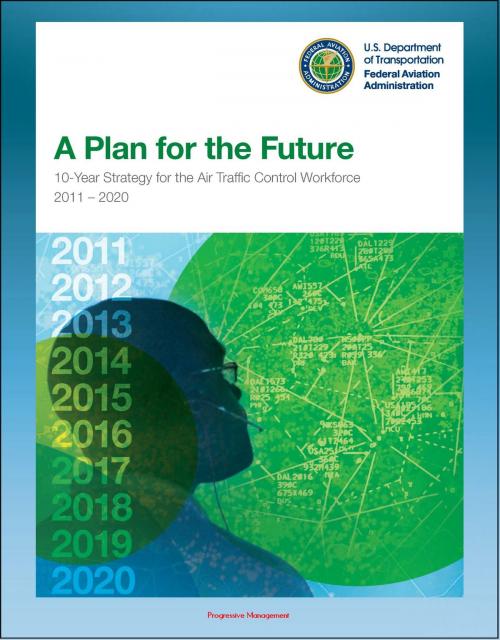A Plan for the Future: 10-Year Strategy for the Air Traffic Control Workforce 2011-2020, TRACON, Terminal and En Route Services, Training and Hiring Process, Staffing Requirements
Nonfiction, Science & Nature, Technology, Aeronautics & Astronautics, Reference & Language, Transportation, Aviation| Author: | Progressive Management | ISBN: | 9781476074894 |
| Publisher: | Progressive Management | Publication: | July 25, 2012 |
| Imprint: | Smashwords Edition | Language: | English |
| Author: | Progressive Management |
| ISBN: | 9781476074894 |
| Publisher: | Progressive Management |
| Publication: | July 25, 2012 |
| Imprint: | Smashwords Edition |
| Language: | English |
This official Federal Aviation Administration (FAA) document - converted for accurate flowing-text ebook format reproduction - presents the updated air traffic controller workforce plan, incorporating changes in air traffic forecasts, controller retirements, and other factors.
Safety is the top priority of the Federal Aviation Administration (FAA) as it manages America's National Airspace System (NAS). Thanks to the expertise of people and the support of technology, tens of thousands of aircraft are guided safely and expeditiously every day through the NAS to their destinations.
Workload - An important part of managing the NAS involves actively aligning controller resources with demand. The FAA "staffs to traffic," matching the number of air traffic controllers at its facilities with traffic volume and workload. The FAA's staffing needs are dynamic due to the dynamic nature of the workload and traffic volume.
Traffic - Air traffic demand has declined significantly since 2000, the peak year for traffic. For the purposes of this plan, air traffic includes aircraft that are controlled, separated and managed by air traffic controllers. This includes commercial passenger and cargo aircraft as well as general aviation and military aircraft. In the past decade, volume has declined by 22 percent and is not expected to return to 2000 levels in the near term.
Headcount - System-wide controller headcount is slightly higher than in 2000. We continue to hire in advance of need to allow sufficient training time for our new hires to replace retiring controllers. On a per-operation basis, the FAA has more fully certified controllers on board today than in 2000.
Contents * Executive Summary * Chapter 1: Introduction * Staffing to Traffic * Meeting the Challenge * Chapter 2: Facilities and Services * Terminal and En Route Air Traffic Services * FAA Air Traffic Control Facilities * Chapter 3: Staffing Requirements * Staffing Ranges * Air Traffic Staffing Standards Overview * Tower Cab Overview * TRACON Overview * En Route Overview * Technological Advances * Chapter 4: Losses * Controller Loss Summary * Actual Controller Retirements * Controller Workforce Age Distribution * Controller Retirement Eligibility * Controller Retirement Pattern * Controller Losses Due to Retirements * Controller Losses Due to Resignations, Removals and Deaths * Developmental Attrition * Academy Attrition * Controller Losses Due to Promotions and Other Transfers * Total Controller Losses * Chapter 5: Hiring Plan * Controller Hiring Profile * Trainee-to-Total-Controller Percentage * Chapter 6: Hiring Process * Controller Hiring Sources * Recruitment * General Hiring Process * Chapter 7: Training * The Training Process * Training Time to CPC * Academy Training * Facility Training * Facility Training Improvements * Chapter 8: Funding Status * Appendix: Facility Staffing Ranges
This official Federal Aviation Administration (FAA) document - converted for accurate flowing-text ebook format reproduction - presents the updated air traffic controller workforce plan, incorporating changes in air traffic forecasts, controller retirements, and other factors.
Safety is the top priority of the Federal Aviation Administration (FAA) as it manages America's National Airspace System (NAS). Thanks to the expertise of people and the support of technology, tens of thousands of aircraft are guided safely and expeditiously every day through the NAS to their destinations.
Workload - An important part of managing the NAS involves actively aligning controller resources with demand. The FAA "staffs to traffic," matching the number of air traffic controllers at its facilities with traffic volume and workload. The FAA's staffing needs are dynamic due to the dynamic nature of the workload and traffic volume.
Traffic - Air traffic demand has declined significantly since 2000, the peak year for traffic. For the purposes of this plan, air traffic includes aircraft that are controlled, separated and managed by air traffic controllers. This includes commercial passenger and cargo aircraft as well as general aviation and military aircraft. In the past decade, volume has declined by 22 percent and is not expected to return to 2000 levels in the near term.
Headcount - System-wide controller headcount is slightly higher than in 2000. We continue to hire in advance of need to allow sufficient training time for our new hires to replace retiring controllers. On a per-operation basis, the FAA has more fully certified controllers on board today than in 2000.
Contents * Executive Summary * Chapter 1: Introduction * Staffing to Traffic * Meeting the Challenge * Chapter 2: Facilities and Services * Terminal and En Route Air Traffic Services * FAA Air Traffic Control Facilities * Chapter 3: Staffing Requirements * Staffing Ranges * Air Traffic Staffing Standards Overview * Tower Cab Overview * TRACON Overview * En Route Overview * Technological Advances * Chapter 4: Losses * Controller Loss Summary * Actual Controller Retirements * Controller Workforce Age Distribution * Controller Retirement Eligibility * Controller Retirement Pattern * Controller Losses Due to Retirements * Controller Losses Due to Resignations, Removals and Deaths * Developmental Attrition * Academy Attrition * Controller Losses Due to Promotions and Other Transfers * Total Controller Losses * Chapter 5: Hiring Plan * Controller Hiring Profile * Trainee-to-Total-Controller Percentage * Chapter 6: Hiring Process * Controller Hiring Sources * Recruitment * General Hiring Process * Chapter 7: Training * The Training Process * Training Time to CPC * Academy Training * Facility Training * Facility Training Improvements * Chapter 8: Funding Status * Appendix: Facility Staffing Ranges















